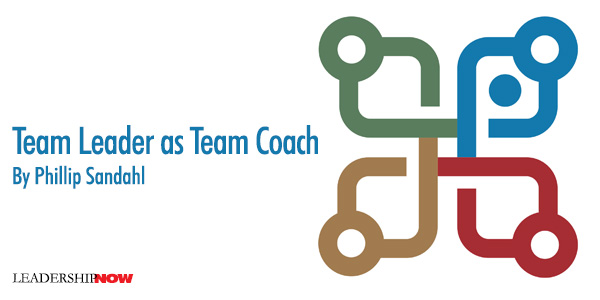 |
 |
12.25.19

Team Leader as Team Coach
TEAMS HAVE PERSONALITIES. You know this from your own experience. Teams go through mood changes. No doubt you’ve felt it after a great team success or alternatively, the gloom and doom when things do not go as planned. It’s a team experience. It’s in the air. It’s mostly invisible, but it affects team performance. There’s an opportunity for leadership in that experience that is generally overlooked. Taking advantage of it as part of team development is an example of the skill set of team leader as team coach. Team leader as coach is not new. It’s a generally accepted leadership competency, working with individual team members, one-on-one. To that now familiar leadership style it’s time to add team leader as team coach: the ability to work with the team as a whole. The goals are similar: support, development, empowerment and ultimately improved team results. The difference is the environment and what that means in terms of skills needed to be effective. The Essential Mind Shift Where individual coaching is almost always a private, confidential dialogue between two people, team coaching happens publicly and in the moment with the whole team present. The conversation has multiple voices and the conversation between team members is just as important, often more important than the conversation between team members and team leader. In the midst of the team working on an issue that is timely and important at the content level, how the team interacts, how the team communicates and how that supports or undermines team performance, is showing up too. You are witnessing the team as a system, playing out team dynamics. It’s a challenge to shift your attention to this wider lens because of course, you’re an active part of the system too. But what it will give you is awareness of the underlying patterns that impact team behavior, and ultimately team results. Real World. Real Time. With a team coaching mindset, team meetings have two purposes: an action purpose and a learning purpose. The action is obvious: attend to the business. The learning purpose is about becoming more aware of the team dynamics. For example, take notice of how the team holds accountability. On your team, is it loose? Rigorous? Situational? Is it a mixed bag and different for different team members? How would you rate accountability on your team based on watching the team in action? Are you satisfied with that score? These are all good questions for your own consideration. They are also good questions to start an important team conversation. Facilitating that conversation is at the heart of team leader as team coach. Just as there are times when you need to be the commander as a leadership style, there are times to be a team coach, engaging the team and building a whole team culture. Intervening can happen during any team discussion when you notice a pattern, a mood change or a disruption in the flow. Obviously, it’s important that you focus on the issue at hand. Decisions need to be made; issues resolved. At the same time there is an opportunity to step back and watch the movie of how the team interacts. Is there permission, even encouragement for bold, out of the box ideas? Or is the team tentative? Based on what you’re seeing, how would you rate trust on this team? Skills for an Effective Team Coach The number one skill is curiosity. Set aside analysis and evaluation for a moment and just be immensely curious. In our training of team coaches we suggest that they imagine they are team anthropologists studying team behavior with a perspective of, “isn’t that interesting.” A second skill, related to being curious is to ask simple, open-ended questions. The best open-ended questions start with “what”, and the most powerful of all is, “what else?” By the way, “Say more” also works. Notice how important tone is when asking a question, especially when it comes from the team leader. Imagine the different ways this question could be delivered: “What made you think this was a viable option?” There is a curious version of that question and an accusatory one too, delivered with a bite. Remembering that here you are coaching the team as a whole rather than individuals, deliver the question openly, to the team. Avoid polling individual team members. A third skill is the practice of being a mirror to the team. This is a skill that includes clarifying, summarizing and active listening. It starts with your observation, “Here’s what I’m noticing…” and invites response from the team. “What do you see?” Or “Does anyone else see that?” Look and Listen Below the Surface That’s where the invisible forces of the team dynamics are at play. You are already well-practiced guiding and following the content level of a team conversation above the surface and get plenty of practice. That’s where the action happens. The learning for you and for the team happens by becoming more aware of what’s happening below the surface. The leadership competency of team coach creates a way to uncover the team dynamics that hold the team back from operating at its best.  
Posted by Michael McKinney at 12:33 AM
|
BUILD YOUR KNOWLEDGE
 

How to Do Your Start-Up Right STRAIGHT TALK FOR START-UPS 
Grow Your Leadership Skills NEW AND UPCOMING LEADERSHIP BOOKS 
Leadership Minute BITE-SIZE CONCEPTS YOU CAN CHEW ON 
Classic Leadership Books BOOKS TO READ BEFORE YOU LEAD |